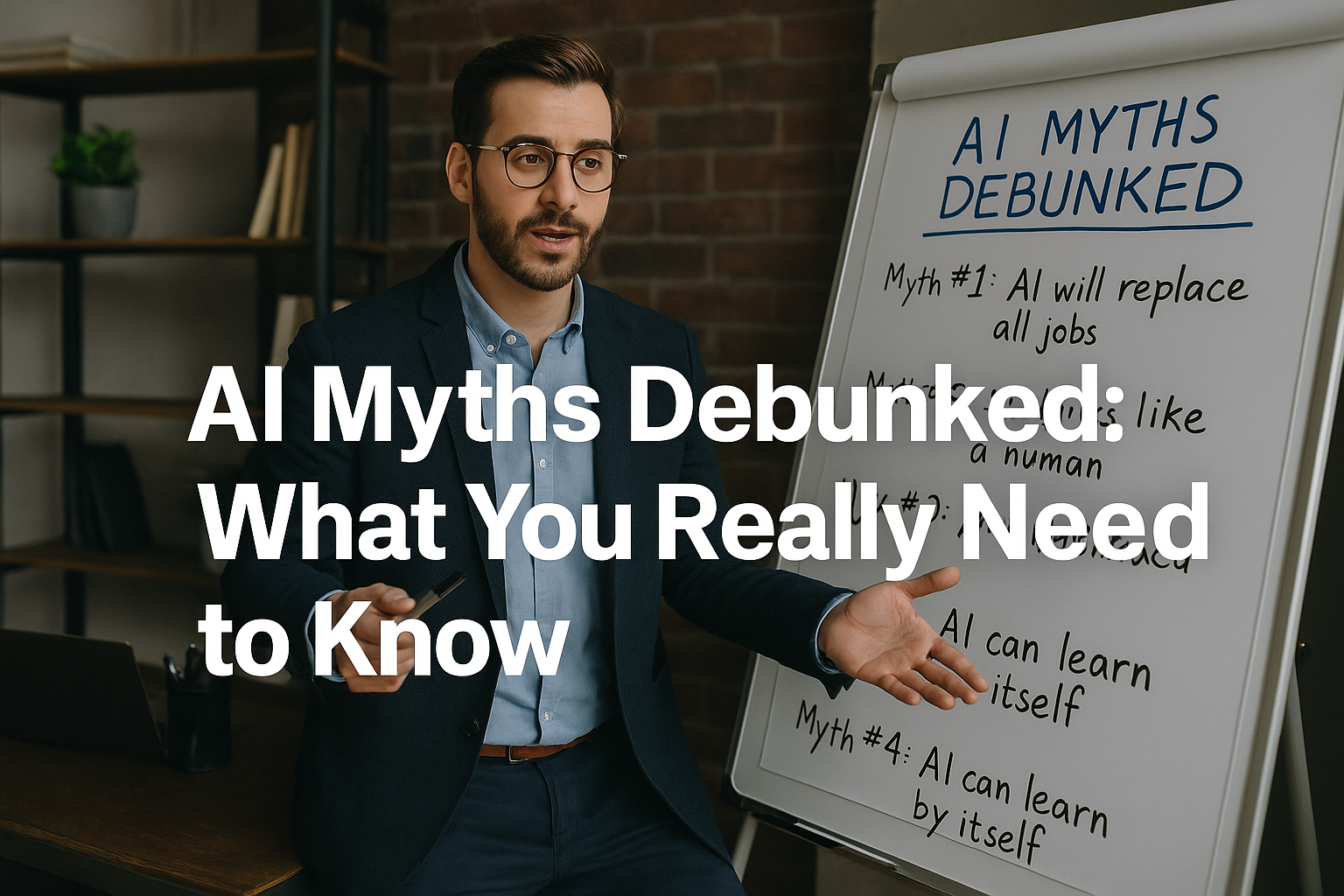Artificial Intelligence (AI) is one of the most transformative technologies of our time — yet it remains surrounded by myths, fears, and misunderstandings. From sci-fi fueled fantasies about robots taking over the world to false assumptions about its capabilities, misinformation about AI can lead to unrealistic expectations or unnecessary panic.
In this article, we’ll break down some of the most common myths about AI and provide a clearer picture of what it actually is — and isn’t.
Myth #1: AI Will Soon Replace All Human Jobs
✅ The Truth:
AI will automate certain tasks, but it’s unlikely to replace entire professions. What’s more realistic is task-based automation, where AI supports humans rather than replacing them.
For example:
- AI can grade multiple-choice tests, but it can’t mentor students.
- It can help write emails, but it doesn’t build long-term client relationships.
The future will likely involve humans working alongside AI — not in competition, but in collaboration.
Myth #2: AI Thinks Like a Human
✅ The Truth:
AI doesn’t think, feel, or reason like we do. It doesn’t “understand” context in a human sense. Instead, it uses patterns in data to predict likely outcomes or responses.
Even the most advanced language models (like ChatGPT) don’t have true consciousness or intent — they are statistical machines trained to mimic language, not understand it.
Myth #3: AI Is Always Objective and Unbiased
✅ The Truth:
AI systems reflect the data they’re trained on — which often includes human biases.
If a hiring algorithm is trained on biased data, it can reinforce those biases (e.g., favoring certain genders or backgrounds). This is why AI ethics and data diversity are so critical.
Developers must constantly audit and adjust AI systems to minimize harmful outcomes.
Myth #4: AI Can Learn Anything by Itself
✅ The Truth:
AI requires massive amounts of human-curated data and guidance. Most models today are not fully autonomous — they depend on humans for:
- Training
- Fine-tuning
- Feedback
Even with reinforcement learning, AI needs guardrails and goals set by people. It can’t just “learn anything” on its own.
Myth #5: More Data = Smarter AI
✅ The Truth:
While large datasets improve performance, more data doesn’t automatically mean better AI. What matters more is:
- The quality of the data
- How well the data is structured
- If the data is relevant to the task
Feeding poor or irrelevant data into a model can degrade performance, not improve it.
Myth #6: AI Is a Recent Invention
✅ The Truth:
AI as a field dates back to the 1950s. The term “artificial intelligence” was coined in 1956 at a conference at Dartmouth College.
What’s new is the availability of:
- Massive datasets
- High-speed computing
- Breakthrough models like transformers
This combination has propelled AI into the mainstream.
Myth #7: AI Is Only for Big Tech Companies
✅ The Truth:
Thanks to cloud-based tools and open-source libraries, anyone can use AI today — from students and freelancers to small businesses.
Tools like:
- ChatGPT
- Midjourney
- DALL·E
- Google Cloud AI
- Microsoft Azure
…are accessible to most people with internet access. Democratization of AI is already happening.
Myth #8: AI Will Inevitably Become Sentient
✅ The Truth:
There is no scientific consensus on whether machines can ever become conscious. Current AI models are far from achieving human-like sentience or self-awareness.
While some researchers explore artificial general intelligence (AGI), this is still speculative. Today’s AI is narrow and task-specific.
Myth #9: AI Can’t Be Creative
✅ The Truth:
AI can generate creative outputs — music, art, poetry — based on patterns it has learned. But it does not “experience” inspiration or emotion.
Instead, it’s excellent at simulating creativity. Human creators often use AI as a tool to enhance their own ideas, not replace them.
Myth #10: AI Is Inherently Dangerous
✅ The Truth:
AI is a tool. Like any tool, its impact depends on how it’s used.
Yes, there are real risks — misuse, bias, surveillance, job displacement — but there are also enormous benefits in fields like medicine, climate science, and education.
What matters is governance, oversight, and ethical development.
Final Thoughts: Clear the Fog Around AI
The world of artificial intelligence is filled with both opportunity and confusion. By debunking these myths, we can make smarter decisions — whether we’re building, using, or simply learning about AI.
Instead of fearing the unknown, we can embrace understanding. With the right information, AI becomes less of a mystery — and more of a powerful ally in solving real-world problems.
